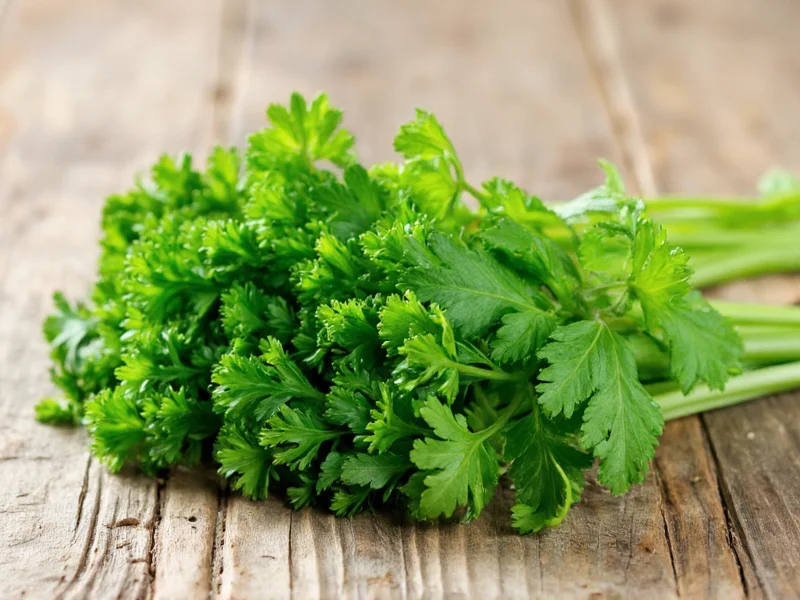Visual Identification: Telling Parsley and Cilantro Apart
Many home cooks struggle to distinguish parsley from cilantro at the grocery store. The key visual differences lie in their leaf structure and growth patterns. Curly parsley (Petroselinum crispum) displays tightly curled, ruffled leaves resembling lettuce, while flat-leaf or Italian parsley has broader, serrated edges. Cilantro (Coriandrum sativum), also called fresh coriander, features delicate, rounded leaves with smooth, lacy edges that resemble baby celery tops.
| Characteristic | Parsley | Cilantro |
|---|---|---|
| Leaf Shape | Curly or flat with serrated edges | Rounded, lacy with smooth edges |
| Color | Bright to dark green | Lighter, more vibrant green |
| Stem | Thicker, more rigid | Thinner, more delicate |
| Smell | Mild, grassy | Strong citrus aroma |
Flavor Profiles: Understanding the Taste Difference
The most significant difference between parsley and cilantro lies in their flavor profiles. Parsley offers a mild, slightly peppery taste with grassy notes that complements rather than dominates dishes. Chefs often use it as a finishing herb to add freshness without altering the fundamental flavor of a dish.
Cilantro delivers a bold, citrusy flavor with notes of lemon and sage. Approximately 20-30% of the population carries a genetic variation that makes cilantro taste like soap due to aldehyde sensitivity. This genetic difference explains why cilantro polarizes palates while parsley remains universally accepted. Understanding why does cilantro taste like soap to some people helps explain its controversial status in culinary circles.
Culinary Applications: When to Use Each Herb
Professional chefs select between parsley and cilantro based on regional cuisine and desired flavor impact. Parsley works well in Mediterranean, European, and American dishes where subtle herbaceous notes enhance without overwhelming. It's ideal for garnishing fish, adding to tabbouleh, or incorporating into gremolata.
Cilantro shines in Latin American, Southeast Asian, and Indian cuisines where its bright, citrusy notes cut through rich flavors. It's essential in salsas, chutneys, and curry pastes. Unlike parsley, cilantro's flavor diminishes significantly when cooked, so chefs typically add it at the end of cooking or use it raw. This distinction matters when considering can I substitute parsley for cilantro in recipes.
Substitution Guidance: Can You Swap Parsley and Cilantro?
While both are green herbs, parsley and cilantro are not direct substitutes due to their distinct flavor profiles. In emergency situations:
- Replace cilantro with parsley only when you want minimal flavor impact
- Use basil or mint as better cilantro alternatives in fresh applications
- For cooked dishes requiring cilantro's citrus notes, add lime zest instead
- When substituting parsley, chervil or celery leaves work better than cilantro
Understanding the difference between parsley and cilantro substitution prevents recipe disasters. Dishes like guacamole or Thai curry suffer when parsley replaces cilantro, while tabbouleh loses authenticity with cilantro instead of parsley.
Nutritional Comparison: Health Benefits
Both herbs offer impressive nutritional profiles with some key differences:
- Parsley contains exceptionally high vitamin K (547% DV per cup), supporting blood clotting and bone health. It also provides 133% of daily vitamin C needs and notable iron content.
- Cilantro offers strong antioxidant properties with higher levels of beta-carotene. It contains compounds that may help lower blood sugar and reduce inflammation.
When comparing parsley and cilantro nutritional value, parsley edges out cilantro in most vitamins and minerals, but both contribute valuable phytonutrients to a balanced diet.
Storage and Freshness Tips
Proper storage extends the shelf life of both herbs:
- Treat both like cut flowers: trim stems and place in water
- Cover loosely with plastic bag in the refrigerator
- Parsley typically lasts 1-2 weeks; cilantro spoils faster (5-7 days)
- Freeze chopped herbs in olive oil for long-term storage
Recognizing how to tell if cilantro has gone bad versus parsley helps reduce food waste. Both develop yellowing leaves and slimy stems when spoiled, but cilantro often shows black spots first.
Growing Your Own: Basic Cultivation
Gardeners can grow both herbs successfully with different approaches:
- Parsley tolerates partial shade and cooler temperatures better than cilantro
- Cilantro bolts (goes to seed) quickly in heat, requiring successive plantings
- Both prefer well-draining soil and consistent moisture
- Harvest outer leaves first to encourage continued growth
Understanding how to grow parsley versus cilantro helps home gardeners maintain a steady supply of fresh herbs throughout the growing season.











 浙公网安备
33010002000092号
浙公网安备
33010002000092号 浙B2-20120091-4
浙B2-20120091-4